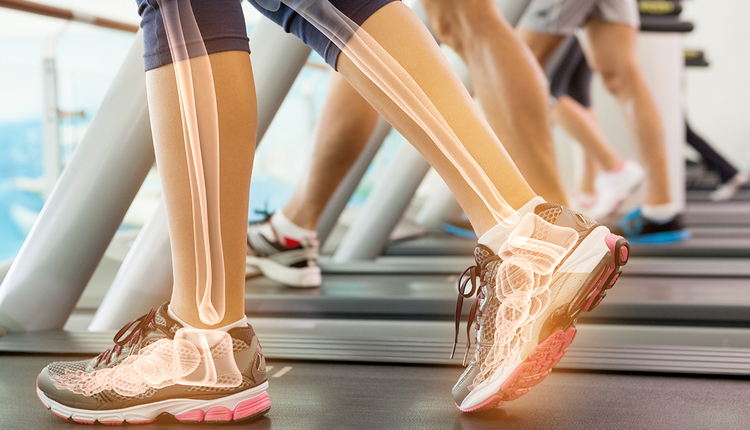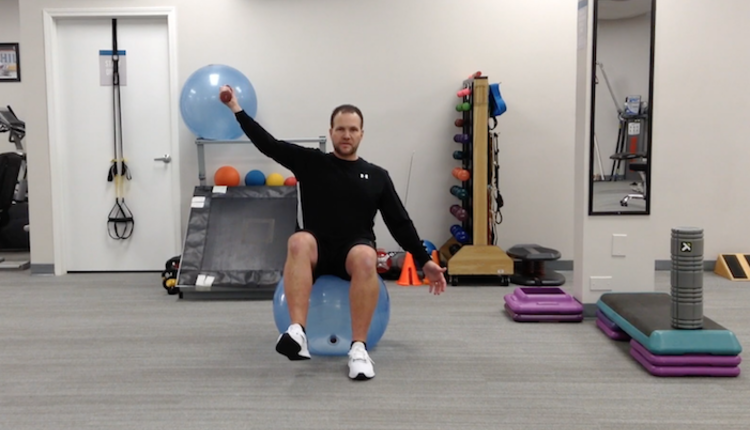
If you work with clients who are 50+, you may be training people on the osteoporosis spectrum – whether they know it or not. As a fitness professional, you can play a key role in helping clients prevent fractures by educating yourself about bone health so you can create safe exercise programs for your clients and make a real difference in their quality of life.
Osteoporosis is characterized by compromised bone strength and a deterioration of the microarchitecture of the bone, which creates fragility and increases risk of fracture. But you don’t have to have osteoporosis to get fractures; people with low bone mass (T score of -1.0 to -2.49) are also at increased risk.
The statistics are sobering: one in 2 women and 1 in 4 men over 50 have low bone mass, and 1 in 3 women and 1 in 5 men may have at least one osteoporotic fracture in their lifetime. Those who have had one fracture are twice as likely to have another. Hip fractures are the most dangerous, leading to loss of independence and even death. Falls are the greatest risk factor for fracture.
Your clients see you a lot more often than they see their doctors, so you have a good chance of seeing a problem before they even think to talk to their physician. Educate yourself by getting to know the risk factors for osteoporosis and understand T-scores and FRAX (see images and resource links).
If you notice any of the following indicators, recommend they get screened:
●They complain about unexplained back pain in the thoracic or lumbar spine
●They’ve sustained a fracture from a fall from standing height
●They’ve lost height in the past year or two of 2cm or more
Strength, balance and fall prevention
As a personal trainer, there’s a lot you can do to help clients. Educate them about osteoporosis, do basic assessments to determine appropriate exercises, set realistic goals, and keep in mind that preventing falls is the best way to keep them fracture-free. When you’re working with older adults and/or those on the osteoporosis spectrum:
●Focus on balance, posture and strength
●Introduce safe movement patterns with exercise, transitions and activities for daily living
●Slow bone loss with resistance training and gentle weight-bearing exercises
Start with a careful assessment, then check back with regular reassessments. If they have a diagnosis, ask for their T-score and FRAX result. (You can do a FRAX assessment without a T-score to estimate fracture risk.) Get a sense of their fitness level, body mechanics and balance. For example, can they hip hinge or get out of a chair without using their arms? Can they stand with their feet together, hands crossed on their chest with eyes closed? Can they balance on one foot for 15-30 seconds?
Strategies for effective exercise
An effective program should include balance training, resistance training, functional movement, cardio and a mind-body component – and take place 2-3 times a week. The higher the risk, the more conservative your program should be. For every exercise you introduce, remember three key guidelines:
1. Keep movements slow and controlled with a neutral spine (no twisting, forward or side bending).
Include a combination of balance, resistance and cardio. Introduce exercises that vary base of support (feet apart, one leg), surface (hard, soft, BOSU), vision (eyes closed, one eye open) and vestibular components (turn head, look up and down). Keep the challenge at an appropriate level.
For resistance training, emphasize form and alignment and progress weight slowly; try spring resistance exercises to enhance core control. Avoid twisting, bending and rapid motions, lifting heavy objects from the floor to overhead, or movements that can compromise arthritic joints. Modify exercises to accommodate limitations: make lunges and squats a little shallower or try planks instead of crunches.
And don’t forget cardio but adapt it as well. While high-impact is good for bones, it’s not so good for arthritic joints; try options such as cycling and elliptical instead. And never do cardio to the exclusion of resistance training!
2. Connect exercises to the movements they make in their daily life.
Focus on biomechanics to help your client understand how to move their body in an optimal way, both at the gym and in their day-to-day. Teach hip hinging versus forward bend. Demonstrate spinal alignment by using a stick on their back for three points of contact: pelvis, spine and head. Teach spine-sparing transitions such as log roll and “marriage proposal” (getting up from kneeling by putting one leg out “proposal” style).
And remember, the gym isn't the only place they're at risk of injury. People hurt themselves every day picking up groceries or vacuuming. Relate body mechanics to everyday activities: e.g. lunge with a straight back as a cue for vacuuming or sweeping.
3. Develop their mind-body awareness.
Understanding how the body moves is vital to improving posture, biomechanics, balance and control. Clients with hyperkyphosis, for example, can be at increased risk of falls and vertebral fractures. Awareness is the first step in change. Exercises that reinforce good posture performed often help to facilitate change.
Grasping concepts like scapular stabilization, pelvic and ribcage placement - and learning how those corrected postures feel in their bodies - can go a long way to helping posture and enhancing balance. Modalities such as yoga and Pilates can help build that awareness; incorporate elements from both into a balanced workout.
Osteoporosis knowledge helps your clients – and you
In the U.S. alone, there are more than 100 million people over 50: demand for older adult programming is on the rise. Being well-versed in the issues that affect this demographic doesn’t just benefit them – it also boosts your marketability and widens the scope of your potential clientele.
You have the ability to change lives. As someone who sees clients every week, you are perfectly positioned to flag concerns and teach them effective strategies for preventing falls by building strength, improving balance, learning proper biomechanics, and staying healthy, fit and safe.
Bone health by the numbers
These two tests help determine where someone is on the osteoporosis spectrum. Knowing what the numbers mean can help you work with older clients.
T-Score: Used to diagnose the presence of osteoporosis, it is the statistical representation of bone density compared to that of a healthy 18- to 30-year-old.
FRAX: Calculates a person’s risk of hip or other major osteoporotic fracture (clinical spine, forearm, hip, or shoulder fracture) in the next 10 years.
Learn more
Risk Factors: https://www.iofbonehealth.org/whos-risk
National Osteoporosis Foundation: www.nof.org
International Osteoporosis Foundation: www.iofbonehealth.org
FRAX assessment tool:https://www.sheffield.ac.uk/FRAX/tool.aspx?country=9
















